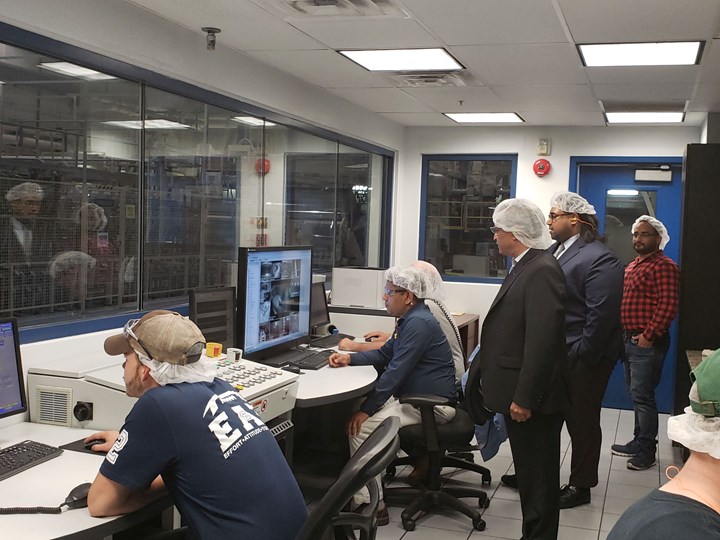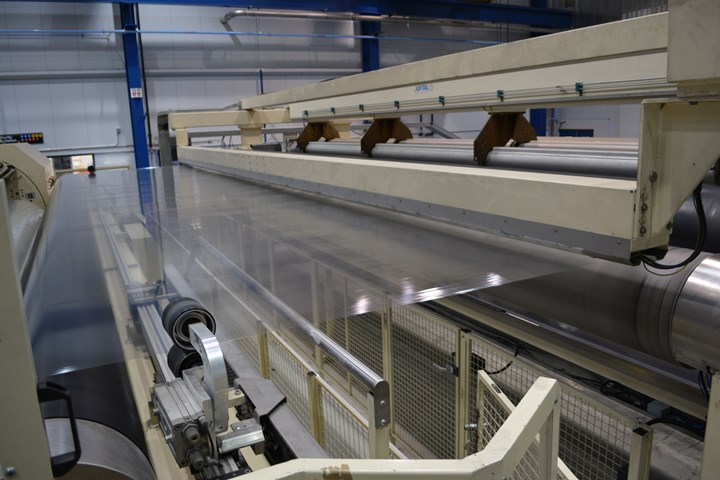A worldwide producer of biaxially oriented packaging films has brought its culture of innovation and commitment to sustainability to the North American market. FlexFilms is the global film manufacturing arm of UFlex Ltd., India’s largest multinational flexible packaging company. With its 2013 opening of a 180,000 ft² plant in Elizabethtown, Ky., the firm has state-of-the-art film manufacturing plants in the U.S., India, United Arab Emirates, Mexico, Egypt and Poland, with cumulative production capacity in excess of 337,000 metric tons (almost 743 million lb) per year, serving brand owners and other customers in roughly 140 countries.
The company’s roots go back to 1994, when it started up its first BOPET line in India. Two years later, it installed a second BOPET line at the same location, along with a line for BOPP production. Through 2003, additional capacity was added for BOPP, metalizing, and cast BOPP. Its first foray out of India occurred in 2005, when it opened a plant in Dubai. In quick succession from 2009 through 2015, it set up plants in Mexico, Egypt, Poland and the U.S. Its strategy all along has been to build greenfield facilities as opposed to using acquisitions to enter new markets. Today, the firm generates about $1 billion in annual global sales.
FlexFilms has been selling in the U.S. since the mid-1990s, first out of New Jersey, then Charlotte and Houston. The pristine, air-conditioned production plant in Kentucky houses one production line for now: an 8.7-meter-wide line supplied by Lindauer Dornier of Germany, producing biaxially oriented PET (BOPET). The line is reportedly the largest of its kind “by far” in North America, says Vijay Yadav. He serves as FlexFilms’ business head and has degrees in polymer engineering and advanced business management.
The Kentucky facility also has equipment for inline barrier metalizing and coating. The metalizer is 2.85 m wide, with a capacity of 5400 m.t./yr. Having metalizing and coating in-house along with film production gives FlexFilms more control over final product quality while also offering customers quick turnaround times.

Flex Films’ Vijay Yadav (l) and Anantshree Chaturvedi installed the largest BOPET line in the U.S. in 2013, measuring 8.7 meters wide.
The facility runs all day, every day, and has a nameplate capacity of 30,000 m.t./yr. Line speeds on average are 470-475 m/min, Yadav says. It produces films in thicknesses from 8 to 50 microns. The plant is situated on 32 acres of property, providing plenty of room for future expansion, says Anantshree Chaturvedi, FlexFilms’ vice chairman and CEO. UFlex was founded in 1984 by Chaturvedi’s father, who he said is considered “the father of the flexible packaging industry in India.”
Globally, FlexFilms has production capacity not only for BOPET, but also for BOPP and cast PP, in addition to metalized and coated films, and a line of specialty films. Its primary markets are food (human and pet) and pharmaceutical packaging, and films for solar and construction applications. It has multiple lines it calls Alox that apply a thin and highly transparent coating of aluminum oxide on films that gives them extremely high moisture and gas barrier rivaling those of aluminium foils and metalized films. FlexFilms says it’s the only truly high-barrier flexible packaging material available that is transparent and allows the packaged product to be clearly visible.

Flex Films’ products can be found in a wide range of products, mostly food (human and pet).
Customized Solutions
Having a global footprint might tempt a supplier of packaging materials to develop technology in one location and apply it across the board. FlexFilms doesn’t operate that way. “We invest heavily in R&D, and make specialized products using specialized formulations,” states Chaturvedi. “But you can’t innovate in one part of the world and believe that the solution will apply globally. Our approach to working with customers is to be close—even local—and holistic. Every roll we produce is customized. Every roll has a unique identity. Our production operation is highly automated, but in a sense everything we make is ‘hand made.’ To be successful in this market you must have more than a transactional relationship with your customer. There must be interaction every step of the way. Moreover, we recognize that there is a certain premium and global recognition that goes with ‘designed and developed in the U.S.’”
“To be successful in this market you must have more than a transactional relationship with your customer. There must be interaction every step of the way.”
Chaturvedi says the FlexFilms’ Kentucky line addresses a market where innovation had become stagnant. “In the U.S., before we came in, I don’t think there had been a new BOPET line installed in 20 years. And we have room for four more lines. The U.S. market requires unique solutions. And there is a clear advantage in being closer to the customer, not only in terms of offering just-in-time delivery but in being able to work more closely on customized solutions.”

FlexFilms runs 24/7/365. Quality control is assured by a production-monitoring system the firm engineered with support from suppliers Dornier and Siemens.
Adds Yadav, “What we bring is a customized solution. We consider our customers to be our product-development partners. We strive to understand their products so that we fully understand what’s required of our products, and we adapt our machinery and our processes accordingly.” FlexFilms runs Davis-Standard extruders equipped with Coperion K-Tron gravimetric dosing units and a Nordson EDI die. Virtually every product it produces is a coextrusion.
FlexFilms runs Davis-Standard extruders equipped with Coperion K-Tron gravimetric dosing units and a Nordson EDI die. Virtually every product it produces is a coextrusion.
It’s as nimble as it is large: Product changeovers are executed in about 10 min, no small feat on a line of this magnitude. FlexFilms utilizes high-voltage pinning to secure the film to chill rolls. From there film is stretched in the machine direction on a series of rolls, then to a series of heating ovens, where the film is clipped at both edges and stretched widthwise at a given temperature. The entire line is 430-ft long.
It designed its process-control system—together with Siemens and Dornier—to provide complete line monitoring. Film samples are pulled regularly on each production run and are checked for gels and a full range of mechanical properties, including haze, tensile, elongation, coefficient of friction, and the like.

Flex Films runs a range of coextrusions at thicknesses down to 8 microns.
States Chaturvedi, “No two products that we engineer are likely to be the same—such is the level of customization we offer. With the support of our dedicated and agile workforce, we ensure an enviable speed-to-market reach, delivering innovation globally much ahead of the competition. Our unwavering focus on quality and sustainability, blended with our capabilities to service any order quantity and ensure Just-In-Time deliveries anywhere in the world, makes us truly unique.”
“No two products that we engineer are likely to be the same; such is the level of customization we offer.”
Driven By Innovation, Sustainability
The company offers a line of “green” films containing up to 90% post-consumer reclaim, as well as halogen-free, ultra-clear barrier PET films with a proprietary coating that is billed as an alternative to PVDC. FlexFilms also manufactures a line of biobased PET films. New solutions include a patented, cold-forming BOPET film for pharmaceutical blister packaging; a series of easy-to-tear BOPET structures; a high-barrier, high-transparency BOPET film—another alternative to PVDC—as thin as 9.5 microns; isotropic metalized BOPET films for lids and seals; a new type of nylon-replacement film made with a newly developed proprietary technology. This film offers good thermoforming performance, high puncture resistance, and flexural fatigue strength suitable for many applications that formerly could be filled only with biaxially oriented nylon.
In its own production process, FlexFilms generates “very little waste,” says Yadav. And this flexible packaging firm is also aware of its role in the ongoing environmental assault against plastics, packaging in particular. FlexFilms is taking a hands-on approach in helping to solve the problem.
In late September, as originally reported by Plastics Technology Executive Editor Matt Naitove, FlexFilms’ parent company UFlex launched Project Plastic Fix, a four-pronged plan involving:
• Recycling of multilayer, multimaterial films with the aid of a compatibilizer into injection and blow molded products like garbage cans, highway dividers, and outdoor furniture. In 1995, the Davos Recycle Forum granted an award to UFlex for recycling printed, laminated film of metalized PET/LDPE/BOPP. In India, FlexFilms utilizes its own recycled films in the form of injection molded core plugs for its film rolls.
• Recycling post-consumer recycled (PCR) monolayer films into new films. FlexFilms has been doing this for 18 months in India and is now offering 90% PCR PET film and will soon launch a 100% PCR product.
• Using pyrolysis to convert plastics not easily recyclable by other means into fuel oil.
• Formulating plastic films to biodegrade into biomass, not “microplastic” particles. UFlex developed a patented “biodegradable enzyme,” called Flexzyme that reportedly allows for 100% degradation by natural soil bacteria. Use life of products can be tuned to months or years before degradation begins. According to Chaturvedi, this is the only commercial technology that allows plastic products to be both fully recyclable and fully biodegradable.
Chaturvedi says UFlex uses all four of these technologies in India now, and plans to introduce them selectively at its facilities in Poland, Mexico, Egypt and U.S. For example, its Mexican BOPET film plant will install an Erema machine to reclaim PCR in the third quarter of 2020. And UFlex is willing to license these technologies to others.
Waste collection for these recycling initiatives, as reported by Naitove, will be done by individuals engaged directly by UFlex—“thus eliminating the middleman that typically would see the largest benefit from these transactions,” according to Chaturvedi. “Importantly, Project Plastic Fix contributes to poverty alleviation, as the person responsible for collecting and depositing the waste receives the maximum return.
“I believe that while plastic cannot be removed from everyday living, it can be used and collected responsibly,” says Chaturvedi. “We can have a solution to use the plastic that the world has already manufactured and ensure that it gets recycled and reused in the economy, in a variety of ways, without affecting the ecology.”
Related Content
How to Estimate and Control Head Pressure
You rightfully worry about melt temperature, but don’t overlook head pressure, because the two are closely linked and will influence line performance.
Read MoreTroubleshooting Screw and Barrel Wear in Extrusion
Extruder screws and barrels will wear over time. If you are seeing a reduction in specific rate and higher discharge temperatures, wear is the likely culprit.
Read MoreFully Automated Extrusion Process Enables Use of Composites for Manufacturing Pressure Tanks
Amtrol was looking for a more cost-effective means to produce thin-wall liners for a new line of pressure tanks. With the help of a team of suppliers, they built one of the world’s most sophisticated extrusion lines.
Read MoreThe Importance of Viscosity in Melting
The calculations required to determine the right melt temperature for each polymer are complicated. Knowing the power-law coefficient and the consistency index of the polymer you run might prove useful.
Read MoreRead Next
Global Packaging Producer Pays Trash Pickers for Recyclable Plastics
UFlex, India’s largest flexible packaging producer will pay people to collect plastics trash for the company’s recycling programs.
Read MoreGlobal Film Processor Sets Sights on U.S. Growth
With six plants in four continents, Flex Films’ strategy is to offer highly customized, ‘holistic’ solutions in BOPET, BOPP, and specialized films and coatings.
Read MoreWhy (and What) You Need to Dry
Other than polyolefins, almost every other polymer exhibits some level of polarity and therefore can absorb a certain amount of moisture from the atmosphere. Here’s a look at some of these materials, and what needs to be done to dry them.
Read More








.png;maxWidth=300;quality=90)






















